Definition | Basics | Benefits | Downsides | Side Effects | Carnivore Diet Plan | Food List
To some, the carnivore diet might sound a bit “out there.”
That’s the diet where you sit down to a breakfast of steak and eggs, a lunch of liver and kidney (perhaps accompanied by some beef suet) and a dinner of ribeye steak with a side of shrimp.
Carnivore proponents say this all-meat approach is the key to unlocking fat loss, regulating blood sugar, even improving mood.
But can all meat, all the time, really be that good for you?
In this story, we’ll explore that question, telling you what you need to know about this increasingly-popular eating style. (Spoiler: the diet might work for some people—but not for the reasons carnivore diet proponents claim.)
You’ll also find:
- A framework that can help you nail down whether the carnivore diet is a good fit
- Our comprehensive plan and food list for getting started (if that’s what you decide to do)
- A FREE downloadable, dietitian-approved carnivore diet guide
As they say, knowledge is power. So no matter why you’re curious about the all-meat trend, we’ve got answers ahead.
++++
What is the carnivore diet?
The carnivore diet is an eating style that focuses on eating meat.
Well, mostly meat. Animal organs, too. (Which are packed with nutrients, FYI).
Versions of the diet have been around for years. One of the earliest modern references dates back to 1856, when a German writer published a book about the virtues of eating only animals.1 More recently, all-meat diets have been popularized by Dr. Shawn Baker (an athlete and orthopedic surgeon), Dr. Paul Saladino (a psychiatrist), and Jordan Peterson (a psychologist).
Carnivore variations range from super strict meat-and-organs-only to iterations that include:
- fish and other types of seafood
- eggs
- animal fats (suet, lard, and tallow)
- small amounts of full-fat, low-lactose dairy
- small amounts of certain fruits and vegetables
(For a complete carnivore diet food list, check out the graphic below.)
Why so much meat?
In the carnivore diet world, you often hear terms like “evolutionarily consistent” and “toxic plant compounds” as proof that the diet works.
Evolutionary consistency means eating the way our ancestors did.
Toxic plant compounds refer to the idea that some plants contain substances that make humans sick.
Let’s take a closer look at each, starting with evolutionary consistency.
Carnivore proponents often point to hunter-gatherer tribes who’ve eaten primarily carnivorous diets for thousands of years. And some research does seem to show that today’s hunter-gatherer tribes (yes, many still exist around the world) have much lower rates of the health problems that plague people who eat a standard Western diet.2
But that’s not the whole story.
Virtually all hunter-gatherer tribes—historical and modern—eat more than just meat. That’s because they have to eat what’s available. Truth be told, plants made up the bulk of what most historical hunter-gatherers consumed.3 4 5 6
Plus, some research shows that groups typically thought of as healthier because of their animal-heavy eating patterns, such as the Inuit, may not have had as much of an advantage as once thought.7
As for those toxic plant compounds? Advocates of the carnivore diet also believe plants aren’t as good for you as everyone says due to the chemical compounds they contain.
One example is lectins, which are found in plant foods like grains and legumes, and essentially serve as built-in defense mechanisms against microorganisms, insects, and other pests. Some people are sensitive to them, and if certain foods aren’t prepared properly (like kidney beans), they can make you sick.
Here’s the thing: As long as you prepare your legumes properly, lectins generally aren’t harmful. (Learn more about lectins and how to prepare foods that contain them.)
Bottom line: There’s no scientific evidence linking the carnivore diet with good health.
We don’t have data on what happens to people long-term. That includes no long-term data on weight and body composition, the digestive system, metabolic health, or anything else.
Still, a quick Google search will uncover an abundance of “incredible carnivore diet results.” So what gives?
In many ways, the carnivore diet isn’t so different from other popular diets.
Sure, the carnivore diet’s rules and rationale are somewhat unique (though there are some parallels with the also-popular Paleo diet).
But, at Precision Nutrition, we’ve seen a lot of diets. We’ve coached over 100,000 clients—and they’ve tried it all: fully plant-based diets, Mediterranean diets, intermittent fasting… and we’ve found that success doesn’t depend on the factors that make any single diet unique.
It’s the stuff these diets all have in common that produces results: eating enough protein, and focusing more on minimally-processed foods and less on highly-processed foods.
For a visual, check out the illustration below. (And if you’d rather use your ears, listen to Diet Debates and Purples States—a fascinating podcast from PN co-founder Dr. John Berardi—that explores the biggest diet debate of our time: plants vs. animals for human health.)
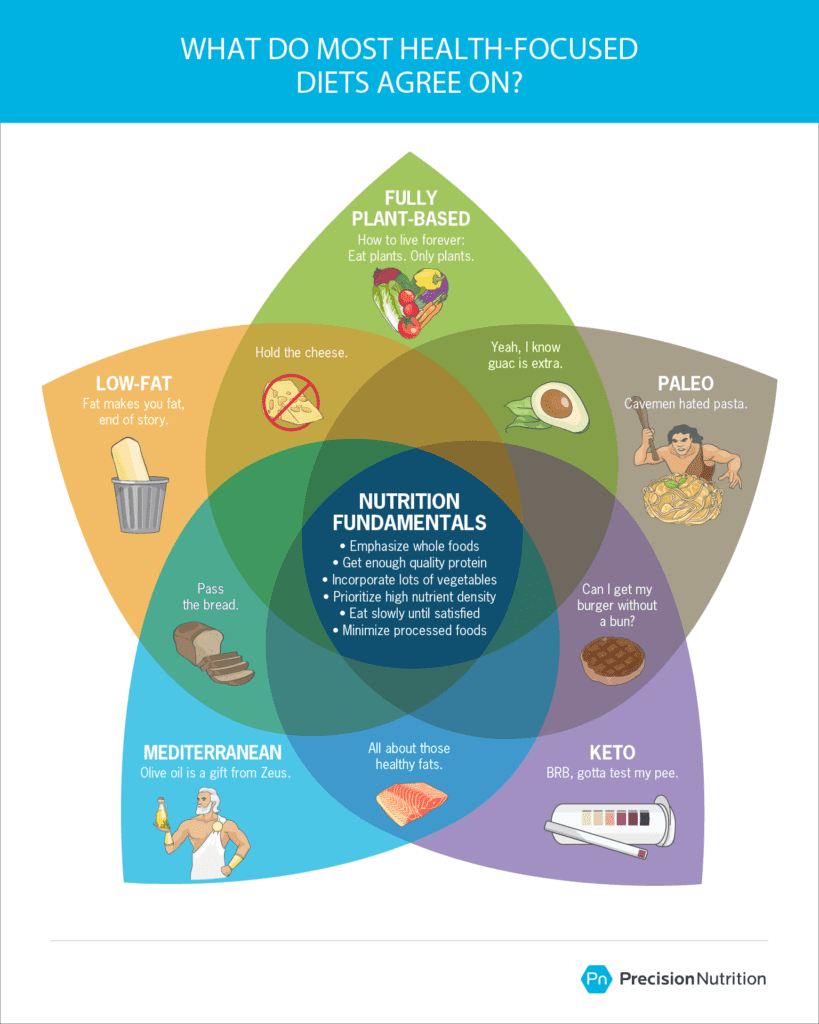
What are the benefits of the carnivore diet?
Some people credit the diet with resolving ailments from metabolic dysfunction to autoimmune problems to arthritis to depression. Others say the eating style gave them all-day energy and the washboard abs they’ve always wanted.
As a reminder, these are anecdotal reports, not results from published studies.
But even so, what is it about eating mostly meat that can feel so transformative for some?
How the carnivore diet might improve health
The carnivore diet is basically an elimination diet.
This eating style is super restrictive. Because of that, people end up drastically reducing the types of foods they eat. And that’s where the diet’s benefits really come from.
People who feel so much better on the carnivore diet are probably addressing an intolerance. Food intolerances can cause a whole range of symptoms: digestive troubles, chronic inflammation, and feeling sluggish.
So it’s not that the carnivore diet is magic. It’s that by omitting dairy, gluten, FODMAPs, and so many other foods, they stop eating what’s causing their problems. End result: they feel better.
(To learn more about food intolerances—and what to do about them—check out our Complete Guide to Elimination Diets.)
This same line of reasoning goes for other health issues that clear up with the carnivore diet.
If a person has metabolic dysfunction, for example, and they normally eat a ton of highly-processed food, they might suddenly find themselves feeling a whole lot better after six weeks on the carnivore diet. Maybe their health markers are even improving.
But it’s not necessarily because they’re eating so much meat.
All the stuff they’re not eating makes a big difference too.
(Think: highly-processed, refined foods.)
How the carnivore diet can lead to weight loss
Similarly, people who experience fat loss on the carnivore diet are likely benefitting (at least in the short term) from the diet’s restrictiveness.
The clear-cut rules reduce decision-making about what to eat. Highly-processed foods are off the menu, and you have to rely on protein, some fat, and maybe some fruits and vegetables to fill your plate. If these are your only food options, you’ll likely end up in a calorie deficit.
(Find out why a calorie deficit is crucial fat loss here: Calories in, calories out: Everything you need to know.)
Potential side effects of the carnivore diet
Because the carnivore diet includes few if any plant foods, you’ll likely be dealing with some nutrient deficiencies. Especially if you keep eating this way for many months.
Yes, liver and other organ meats are loaded with good stuff. But here’s something liver has none of: fiber.
That means you may experience constipation.
Plus, all the evidence we have about our microbiome suggests that a diverse and fiber-rich diet is the best thing for your gut.8
Several vitamins are hard to come by on a carnivore diet, including vitamin C, which is found in citrus fruits, peppers, berries, and other plant foods.
And then there are all the phytonutrients—healthful chemicals only found in plant foods—you miss out on by following this diet. Research strongly suggests that these provide all kinds of health benefits.9,10
Other downsides of the carnivore diet
There’s another really big con here, and I’ve already mentioned it.
This diet is extremely restrictive, which may help some people at first. But when it comes to long-term health outcomes, restrictiveness is not an asset.
Let’s take weight loss. No one goes into a restrictive diet thinking: “I want to lose 30 pounds, then put it back on when I can’t follow this anymore.”
Right?
When you look at the research on people following highly restrictive diets in the long term, the vast majority end up regressing toward their old eating habits.11,12,13
Why? Following a carnivore diet long term means, sorry, you can’t eat cake at your kid’s birthday party this year, or on your birthday. (Although maybe you could enjoy some… meat cake?)
When you go out for drinks with colleagues, no booze for you. Because, that’s right, all alcohol is plant-based. And Grandma’s lasagna? Not a chance.
If your goal is to lose weight and keep it off, you need to have a plan that allows your diet to become more sustainable. The same goes for people trying the carnivore diet to deal with a specific health issue.
So do we recommend the carnivore diet?
Not really.
But we also wouldn’t discourage someone from trying it. (If you’re a coach, you can learn more about how to approach these trendy diets in our article: Surviving the Dr. Oz Diet.)
Instead, we help set them up for success. How, you ask? See below.
The smart carnivore diet plan
To determine the right level of carnivory for you (yes, carnivory is a real word), use the three-step process outlined here. It’ll take you from a strict carnivore diet to something that’s ultimately more sustainable.
Think of it as a diet experiment—one that’ll help you figure out which foods are right for your body. (Also, if you’re into the whole experimentation thing, check out this article: Three diet experiments that can transform your body.)
REMINDER: You can download this FREE carnivore diet plan, print it, keep it handy on your phone, or share it with a client.
The evolution of the carnivore diet
The carnivore diet started out as a strict all-meat experience.
But the approach is starting to evolve, perhaps because of the issues we’ve mentioned in this article.
You have the animal-only people, of course. But we’re also seeing some of the leaders in the space talk about how they’re starting to eat the following foods that were previously considered off-limits:
- Higher-lactose forms of dairy
- Certain fruits and vegetables (such as squash, avocados, and small amounts of fruit)
Some of them even consume a bit of white rice. (Scandal!)
So taking the approach outlined below isn’t necessarily inconsistent with carnivore diet ideology.
In fact, this might be the direction the diet is headed.
Step 1: Check in with your healthcare provider.
You’ve probably heard this advice before, but it’s important to have a conversation with your doctor, nurse practitioner, or main healthcare provider before starting the carnivore diet.
Let your provider know you’re trying an all-meat diet, and that you’d like to keep track of how things are going during the process. They might recommend a standard blood panel that includes blood lipids, blood sugar, and markers of inflammation.
They might also want to keep track of your nutrient status with blood tests to ensure that you’re not starting out deficient in any key nutrients.
During this appointment, ask your provider how often you should check in with them to repeat any of the tests they’re performing in this initial stage.
Step 2: The elimination phase
Now you’re ready to start on either the strict carnivore diet or the modified carnivore diet.
Take a look at the chart below, and decide what would be the best fit for you. If you’re comfortable with a more restrictive approach, then the strict carnivore diet could feel right. If you think something more moderate would be better, try the modified version.
Remember: We’re treating this like an elimination diet, so this phase will be short, lasting anywhere from two to six weeks, depending on your preference.
Important note: If eating only meat is giving you non-stop diarrhea or constipation, feel free to abort this mission.
After at least two weeks, use the How’s The Carnivore Diet Working for You? Assessment in the PDF to gain insight into your experience. Hang onto your results, because you’ll need them later for comparison.
Step 3: The reintroduction phase
Now it’s time to systematically reintroduce foods, and see how you respond.
Of course, if you’re completely happy with how things are going on a stricter version of the diet—you don’t feel like you’re missing out, you’re feeling good, and your blood work looks great—you could keep going the way you are. Based on our experience, though, people are usually ready to have a little more variety in their diet by this point.
During the process, you can take notes in the How Food Feels Journal (also found in the carnivore diet PDF). Here’s how it works:
Day 1: Reintroduce one food, eating at least two servings of it at different times of the day. For example, you might reintroduce Greek yogurt by having it at breakfast and lunch.
Days 2 and 3: Stop eating the new food.
Day 4 and beyond: What happens after day 4 will depend on how things went on days 2 and 3.
- If you feel great, add the food you just reintroduced to your “safe” list, and reintroduce a different food the next day.
- If you experience a reaction, take note and wait until the symptoms subside before reintroducing another food.
Keep introducing foods and noticing how you react.
The foods in the modified carnivore diet and sustainable carnivore diet columns are a great place to start, but you’re not limited to just these foods. The point is to create a diet that works for you. So include those must-have foods that make your life worth living.
Every so often, return to the How’s The Carnivore Diet Working for You? Assessment from the PDF to check in on your progress. That way, you can:
- Compare how you feel now to how you felt during the elimination phase
- Ensure you’re still on track with the goals that drove you to try the carnivore diet in the first place
You might also want to follow up with your doctor after a few months to check your objective health markers.
(By the way, in case you’re the type that likes to understand every detail, we have an entire ebook on elimination diets that’s TOTALLY FREE.)
The bottom line
It’s difficult to argue with dramatic before and after pictures, or firsthand stories of incredible results.
We see this effect with all kinds of trendy diets, and the carnivore diet is no exception. But for every success story, there are probably hundreds of people the carnivore diet didn’t work out for, mostly because of how restrictive it is.
That doesn’t mean you can’t try it if you want to.
Just remember: It’s an experiment.
If it works out for you, that’s awesome.
And if it doesn’t, try not to think of it as a failure. You gain valuable insights when you try a new eating approach—even if the biggest insight is “I hate that diet!”
So mainly, don’t beat yourself up. Because the carnivore diet isn’t right for everyone… and millions of healthy plant-based eaters will attest to that.
References
Click here to view the information sources referenced in this article.
If you’re a coach, or you want to be…
You can help people build sustainable nutrition and lifestyle habits that will significantly improve their physical and mental health—while you make a great living doing what you love. We'll show you how.
If you’d like to learn more, consider the PN Level 1 Nutrition Coaching Certification. (You can enroll now at a big discount.)

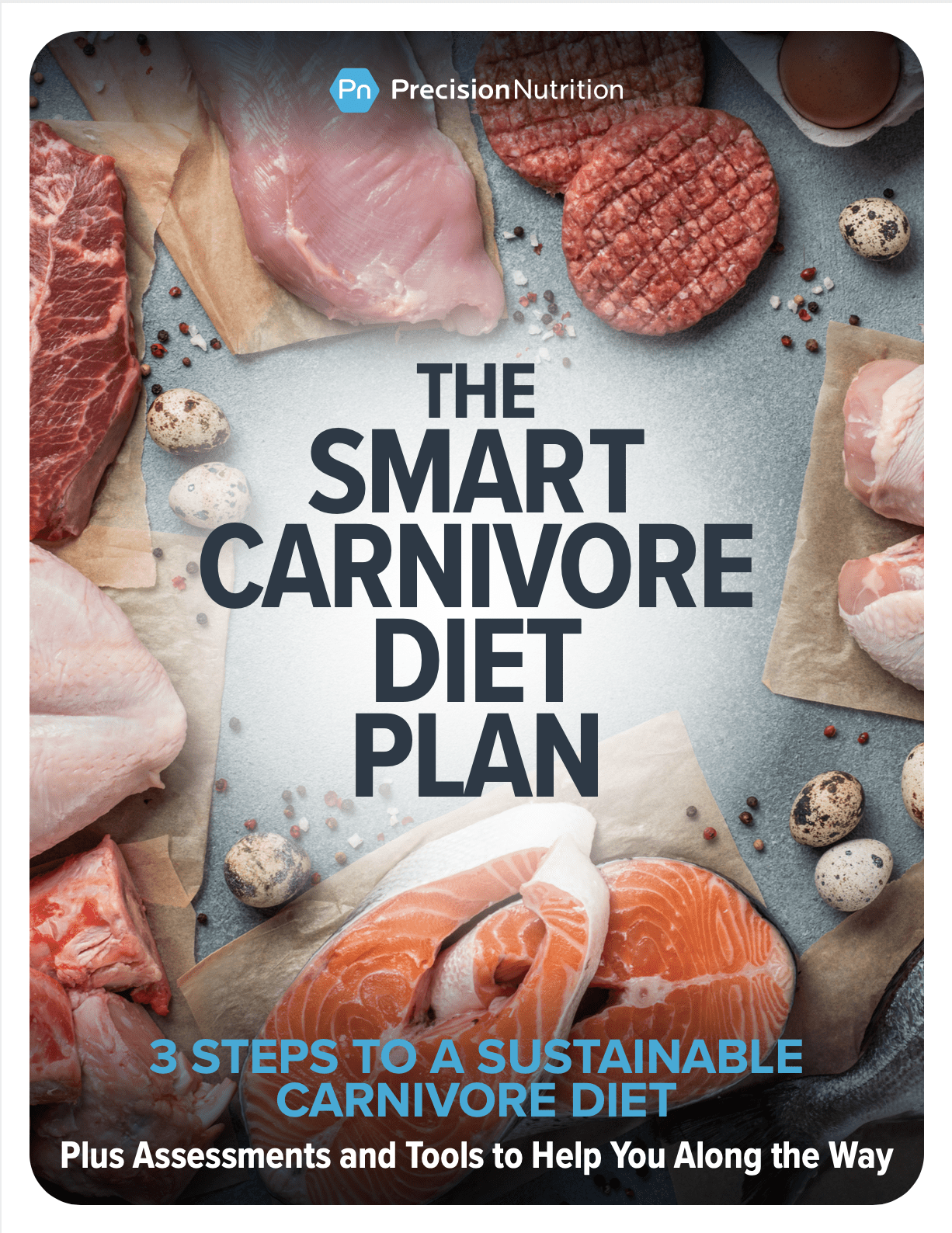

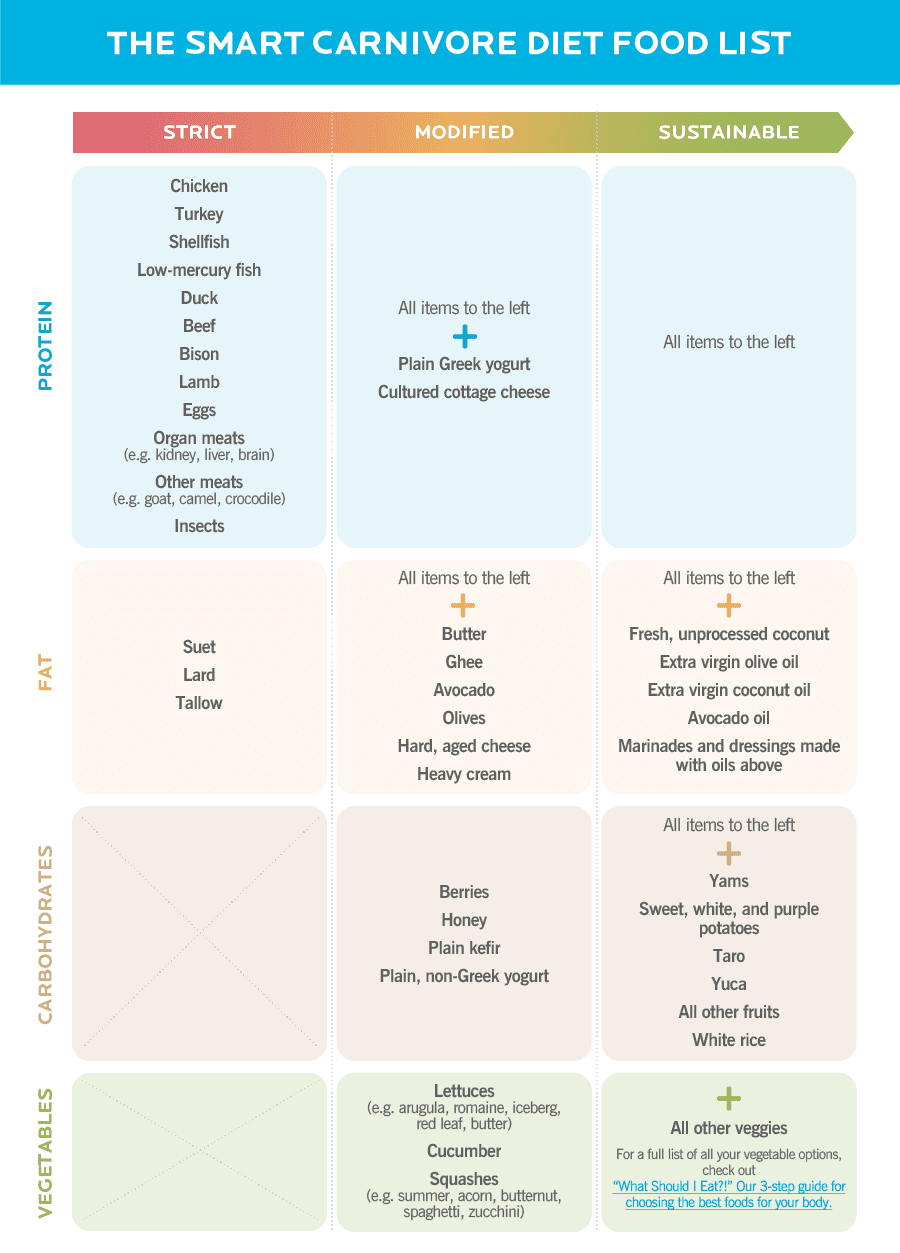

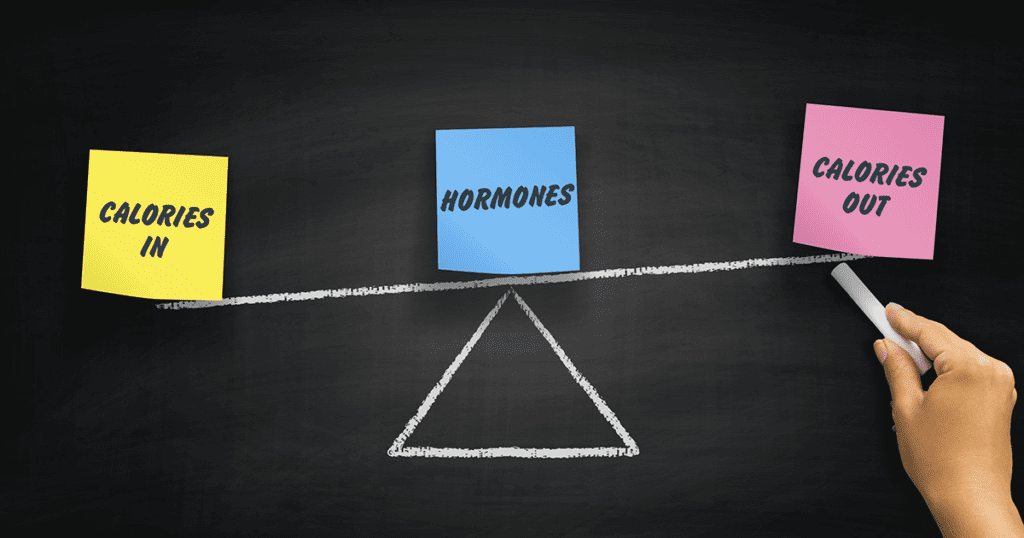
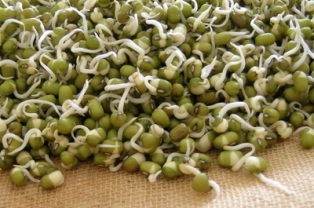


Share